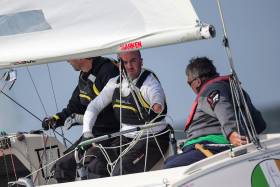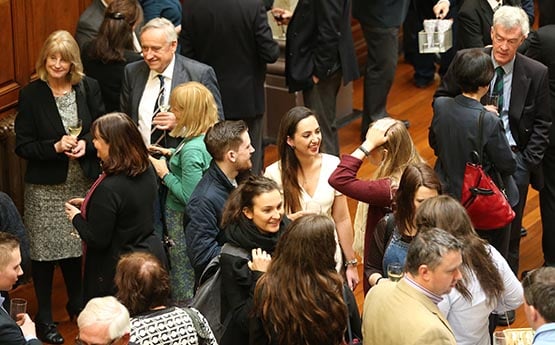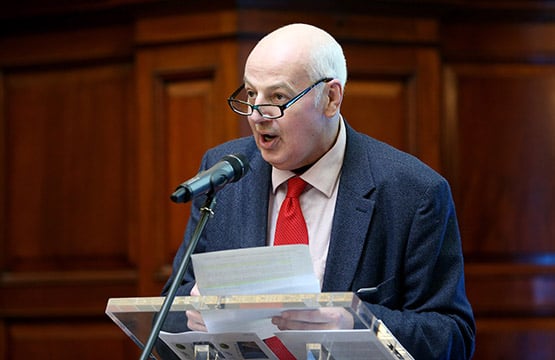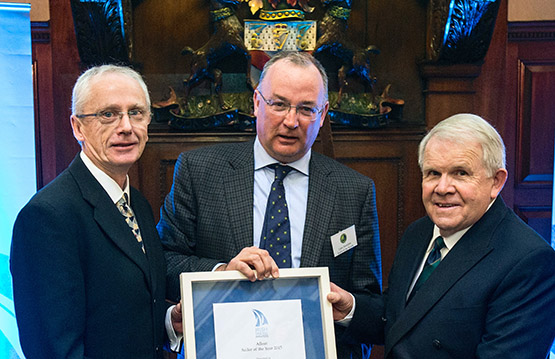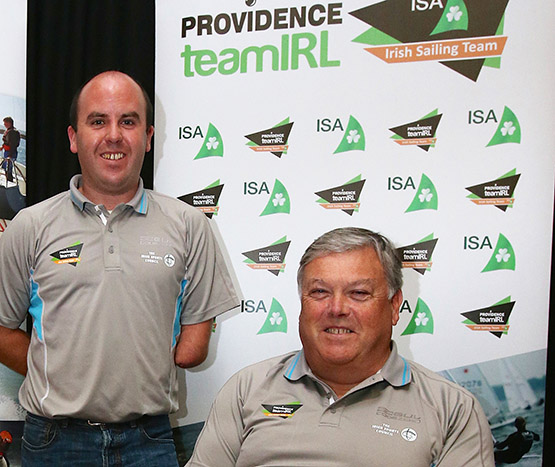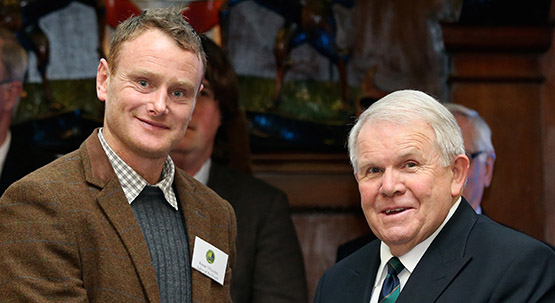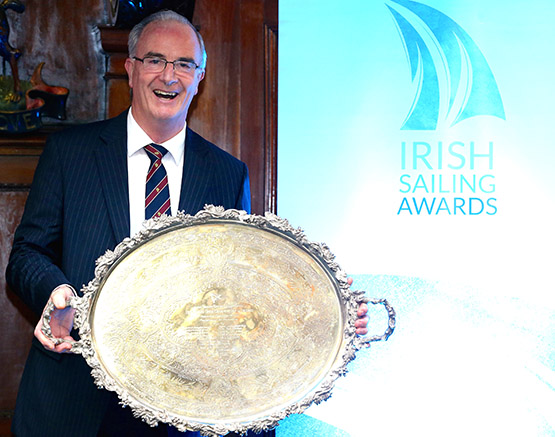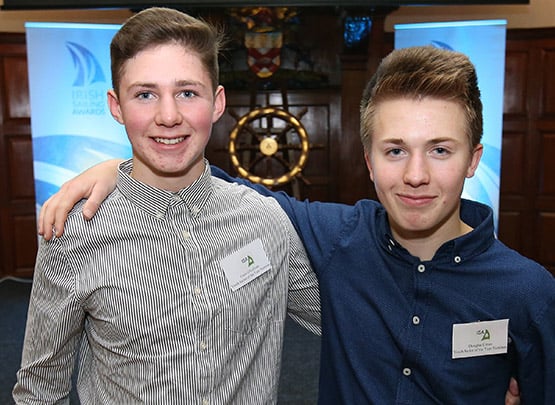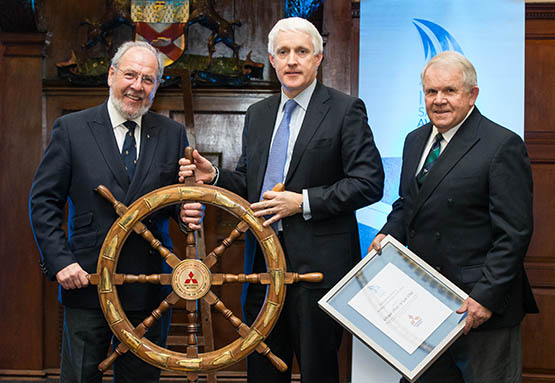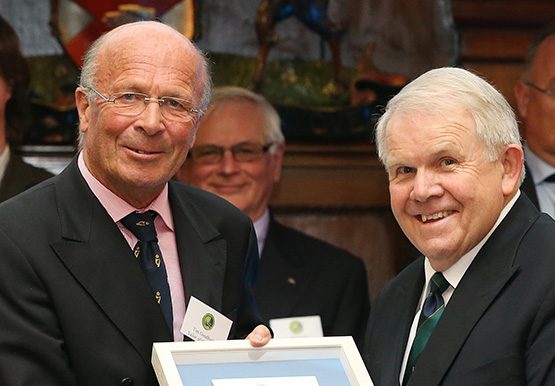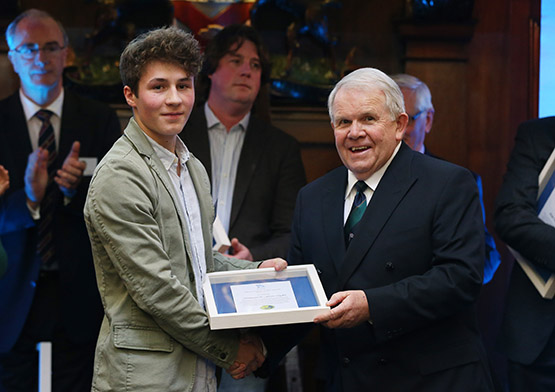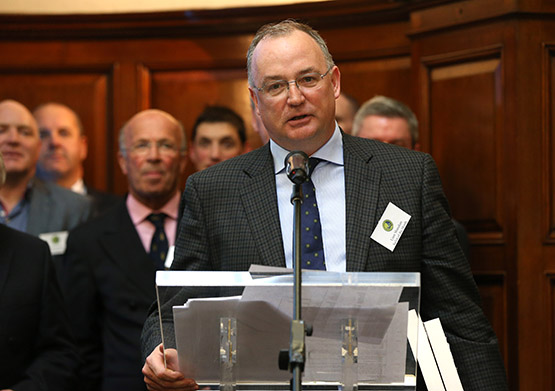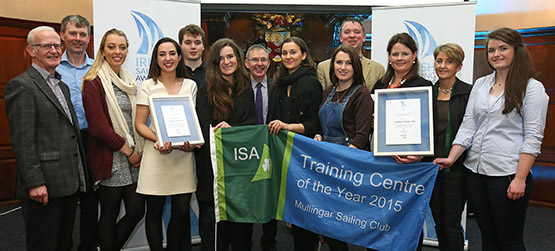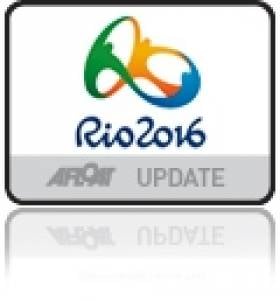Displaying items by tag: John Twomey
The 2016 Para World Sailing Championships came to a breathtaking finale in Medemblik, the Netherlands as the final race of the championships decided the medals in the Sonar fleet.
Arguably the most exciting race of the day was in the Sonar fleet as the gold medal changed hands continuously throughout. Ireland's John Twomey, Austin O'Carroll and Ian Costelloe were ninth overall in the 16–boat fleet.
Norway's Aleksander Wang-Hansen, Marie Solberg and Per Kristiansen took a bullet in the first race of the day to bunch the top four together, only separated by six points going in to the final race. The battle was on.
The final race started with USA on top, but they fell behind early and were down on the predictive rankings. Australia and Great Britain moved ahead and they changed top position on the predictive. Throw in Norway who moved up the fleet. Then USA came back. The top four on the leader board were the top four on the course fighting it out.
Great Britain's John Robertson, Hannah Stodel and Steve Thomas took the bullet, but only just from Australia's Colin Harrison, Jonathan Harris and Russell Boaden. The Britons had to wait and see if Norway could do them a favour and beat the American's to the line. They couldn't. USA's Alphonsus Doerr, Bradley Kendell and Hugh Freund had done it, they were world champions.
Describing the race, Kendall said, "The last race of the day, last race of the regatta, we knew who we had to cover and we were happy with our start, we knew where they were. The first shift we actually didn't sail to the right side that we wanted to and we had to fight our way back, but we did that.”
With four team's vying for the medals in such a close contest, Kendall was happy to get the job done, "This world championship was a very tight regatta. The world's best were here and we are so happy with what we have done and where we are at right now.”
Where they are right now is on the top of the podium and 2016 Para World Sailing Champions with 26 points.
With the final bullet of the championships, John Robertson, Hannah Stodel and Steve Thomas took the silver medal on 27 points with Colin Harrison, Jonathan Harris and Russell Boaden taking the bronze on 28.
Irish Sailing Celebrates the Best of the Best
The Irish Sailing Association Annual Awards ceremony undoubtedly conveyed three clearcut messages. The first is that, in global sailing terms, we’re a wet and breezy little island which nevertheless punches way above our weight. The second is that we live comfortably with a long and very distinguished history of recreational sailing which puts most other nations in the shade. And the third is that Ireland is definitely not the greatest place in the world to be a professional sailor. W M Nixon takes a look back at Thursday’s annual prizefest.
Those unfamiliar with the Royal College of Surgeons in Ireland might think it odd that, in just two short years, its splendid College Hall, at the very epicentre of Dublin on Stephens Green, has come to be seen as the most natural focal point for the annual honouring of our top sailors and clubs.
The College Hall in the RCSI provides an ideal setting for the annual gathering for Irish sailing’s national awards.
Sailors talking about sailing. The Awards Ceremony provides a cherished opportunity for sailors from every discipline to shoot the breeze together.
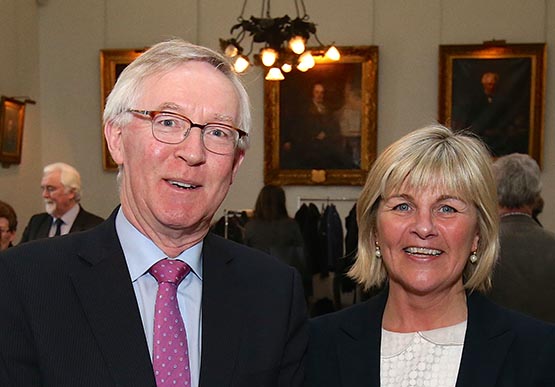
Dragons Den star Bobby Kerr – a sailing man himself – was the lively Master of Ceremonies
But in terms of being a setting which lends itself very positively to such a gathering, College Hall is right on target. It’s a splendid room which is confident with itself without being over the top. It comfortably accommodates the crowd of between 180 and 200 who have come from all over Ireland to celebrate what’s best in our sailing. And as if that weren’t enough, the RCSI has remarkable links with sailing going back more than a hundred years.
John Treacy, CEO of the Sports Council, with Liam Shanahan and ISA President David Lovegrove
So after last year’s first use of the venue, which stemmed from a typically far-sighted suggestion by ISA Board Member Brian Craig, people were keen to go back. And it wasn’t because no-one could think of anywhere better. On the contrary, it was because we’d found that the College of Surgeons is one of those wonderful buildings which make you feel better just from being in it. So in the early days of Spring when we wonder if summer is really going to come at all, a bit of a party in the College of Surgeons is just what the doctor ordered. And as for those doctors and surgeons from the RCSI going sailing, we’ll return to that at the end of this piece. But what of the event itself?
Well, with the Afloat.ie Sailor of the Year award going to a determinedly Corinthian skipper who cheerfully admitted that there’s any amount of professional sailors out there who could probably beat the pants off him, but nevertheless his core interest is offshore racing with family and friends, and if they win within those self-imposed limitations, then so much the better…..There it was, the real voice of Irish sailing, and no mistake.
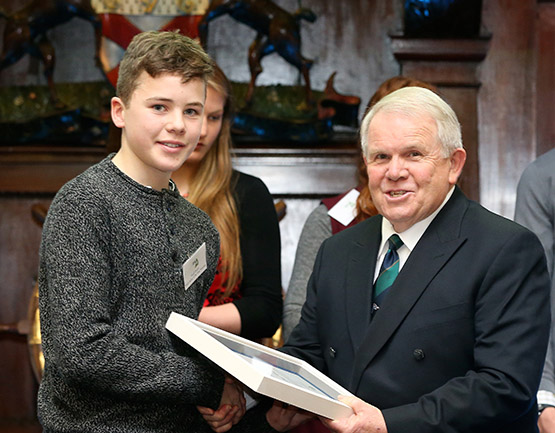
Pierce Purcell of Galway Bay SC with the RIYC’s Michael Boyd, Commodore of the Royal Ocean Racing Club
But what about the clubs through which we go sailing? How can they carry such a wealth of history, and yet be of any contemporary relevance? Here again, the evidence speaks for itself. The new Mitsubishi Motors Sailing Club of the Year has a wonderful history going back to 1831, yet in terms of sailing achievement and voluntary input into the local, regional and national organisation of sailing, it is making a fantastic contribution. And as for its relevance to sailing in the future, independently of the Club of the Year adjudication taking place, this same club was comfortably on its way to being the top ISA Training Establishment in its region, and on the shortlist for the national title too.
Olympian and rising stars – James Espey, Aoife Hopkins and Saskia Tidey
If that’s not an illustration of the way that Irish sailing honours its past while living in the present and looking to the future, then I don’t know what it is. But what’s this third point about Ireland being a cold place for professional sailing? Here again, the assembly in the RCSI was very representative of our Irish sailing population. For sure, there are some very distinguished Irish professional sailors, and there are certainly Irish owners who are prepared to pay the top talents to sail with them. But there’s something about the Irish sailing scene which is inimical to such a setup at home. By all means do it where the weather’s usually benign, and there’s lots of money floating around. But in the Irish climate you sometimes have to be so keen to go sailing despite hostile weather that you just have to rely on nutty amateur crew - the professionals know there’s much better and more reliable pickings elsewhere.
Thus we’ve come to the ironic situation that our top home-based professional sailors are actually our Olympic hopefuls. It’s extraordinary when you think that the modern Olympics were “re-founded” in 1896 in order to celebrate amateur sport, yet now in Ireland just about the only home-based sailors who can be said to be professional are the Olympic aspirants. And if they haven’t accepted that they need a professional approach, then they’re not really at the races at all.
Thus although the friendly Olympian presence of Annalise Murphy, James Espey and Saskia Tidey was much to be welcomed in the very representative throng, generally anyone who was there with any sort of a professional interest in sailing had it as part of a larger business in which actually going sailing is only a small part of the total setup.
Paralympic sailors Ian Costello and John Twomey
Admittedly we did have one Olympian who received an award, John Twomey who took the title in December for his qualification for the Paralympics in September 2016. And he came with added laurels, as on the very day of the ceremony, it had been announced that he and his crew of Ian Costello and Austin O’Carroll had moved up to fifth in the World Rankings. But if you suggested to John Twomey – headed for his 11th Olympiad – that he’s a professional sailor, he’d be convulsed in mirth. Real life is related to an accountancy practice in Kinsale.
So the only other monthly awardee who could remotely be said to be a professional sailor was August winner Ronan O Siochru. who skippered the winning Irish Offshore Sailing boat Desert Star to victory in the 33-strong Sailing Schools Division in the Rolex Fastnet Race 2015. But he’s very definitely running a business - and a very demanding one at that – in which going sailing is only part of it.
Ronan O Siochru with the President
Thus what Thursday’s ceremony was all about was voluntarism and amateur sport, and in case anybody missed the point, it was supposed to be a bit of fun. In this spirit, the greatest trophy in Irish sailing, the might salver for the Helmsman’s Championship, was given an outing. The All Ireland Helmsman’s Championship being an amateurs-only affair, as it is held over an October weekend, inevitably by the time its award ceremony for the salver is shaping up it’s well into Sunday evening. It’s getting dark, and everyone’s tired and wants to go home. So inevitably the handing-over of the historic trophy is a downbeat and somewhat rushed affair.
But as the ISA Annual Awards ceremony is all about handing over prizes with as much ceremony as possible, it was arranged for the salver – which had been hurriedly handed over to successful defender Anthony O’Leary in Dun Laoghaire back in October – to be smuggled out of the O’Leary household down in Crosshaven, secretly taken to Dublin, hidden away in the College of Surgeons, and then formally presented as a surprise extra to the great man after he’d received his Sailor of the Month award for April. He blushed.
Got him! Sailor of the Year 2014 Anthony O’Leary unavoidably missed last year’s awards ceremony, and then in 2015, although though he was Sailor of the Month for April, there were very few people around in October when he successfully defended the Helmsmans Championship Salver. So it was taken secretly to this week’s ceremony, where more than 180 people cheered him to the rafters.
ISA Youth Champions 2015 are Colin O’Sullivan and Doug Elmes, Bronze Medallists in the 420 Worlds.
Before all this, we’d been setting the scene with the ISA Youth Sailors of the Year, who were 420 Worlds Bronze Medallists Douglas Elmes and Colin O’Sullivan, and the ISA Training Centre of the Year, which was Mullingar Sailing Club from Westmeath which headed the Western Region, and overall came in ahead of Foynes YC from the Southern Region and the Royal Irish YC from the Eastern Region.
Katie Johnston of Mullingar Sailing Club with David Lovegrove when MSC was announced as ISA Training Centre 2015.
The new Mitsubishi Motors Sailing Club of the Year is the Royal Irish YC – Commodore James Horan with Billy Riordan of Mitsubishi Motors and David Lovegrove.
But for the RIYC Commodore James Horan, the good news was only beginning, as his club was then announced as the new Mitsubishi Motors Sailing Club of the Year for a host of excellent reasons. We’ll list them in more detail here on Afloat.ie in due course when the traditional handing-over ceremony for the old ship’s wheel trophy is held in the RIYC clubhouse later in the Spring. But meanwhile on Thursday we saw ample reason for it, as two of the Sailor of the Month awards went to very active RIYC members, George Sisk and Tim Goodbody.
July Sailor of the Month George Sisk with the ISA President
Dun Laoghaire Regatta Week 2015 Chairman, Fastnet Race 1987 overall winner, and multiple champion Tim Goodbody was Sailor of the Month in November
Youngest cruising award winner was Fergus Ogden, who in June and July sailed round Ireland with his brother in an open Drascombe Lugger.
Then came the Sailor of the Year announcement. Anyone who was following the voting in the Afloat.ie poll will know it was running very close. But as the poll results are only a quarter of the adjudication process, it was just a couple of days ahead of the awards ceremony when the judges finally made their decision. They came down in favour of Liam Shanahan both for his wonderful and very sporting victory in the Dun Laoghaire to Dingle Race with his family’s J/109 Ruth, and his subsequent success in retaining the Irish Sea Annual Championship title.
His modest acceptance speech was, in effect, a manifesto on behalf of all Irish amateur sailors, and particularly family sailors. The Shanahans are one remarkable sailing tribe right through three generations. And as for that win in the Dun Laoghaire to Dingle Race – well, it was beautiful sailing. Some sailing races are won by brutal slugging. Some are won by sheer cunning. Some inshore races are even won by dirty sailing, and it’s within the rules even if it does the image of our sport no good at all. But some race wins are simply beautiful sailing. And Ruth’s success in Dingle was definitely in that category.
After receiving his award, Liam Shanahan briefly but eloquently outlines his philosophy of sailing
So the ceremony on Thursday concluded with this celebration of the best in Irish sailing, and it chimed well with the mood of the moment and the location, as the current President of the RCSI is Declan Magee who sails from Dun Laoghaire, and he was most welcome at the party and naturally thanked for the use of the hall……
Then as we exited the College Hall, the first doorway we passed was the Sir Thomas Myles Room. He was RCSI President 1900-1902, a wonderful surgeon and a man of prodigious energy who boxed to championship level, and adored sailing. A Home Ruler of Limerick origins. he made his auxiliary ketch Chotah available to take the guns off Conor O’Brien’s Kelpie during the Asgard gun-running of 1914, and landed them in Kilcoole in County Wicklow. And though he was immediately made a Colonel and head of British army surgical services in Ireland on the outbreak of the Great War of 1914-18, he also saw to it that hidden rooms in the major Dublin hospitals under his control were available to treat wounded rebels, indeed anyone who was wounded, during the Rising of 1916.
Builders of the future – the team from Mullingar Sailing Club, ISA Training centre 2015
More recently, a leading sailing figure with links to sailing is Michael O’Rahilly who, when he became a student at RCSI at the end of the 2950s, found that the RCSI Sailing Club consisted of just one neglected Firefly dinghy. By the time he graduated in 1963, he was Club Captain, RCSISC had three Fireflies in top racing condition, and they were the Irish university champions.
Subsequently he went in to play a leading role in Dublin Bay SC, and was the Commodore for the DBSC Centenary in 1984. He follows in a notable RCSI tradition of sailing and working voluntarily for our sport, as an earlier top sailor in the college had been Jimmy Mooney who played a key role in the development of Irish dinghy sailing, and then went on to be our top Dragon sailor for many years, winning the Edinburgh Cup and representing Ireland in the Olympics.
Before Jimmy Mooney another noted character in the RCSI sailing scene was Rory O’Hanlon, who became a noted figure in offshore racing – he won a cup in the 1971 Fastnet Race – and was further renowned for his long distance cruising exploits.
He was noted as a kindly mentor to young cruising hopefuls, gently giving encouragement which could make all the difference to a nervous skipper. One such beginner, who later went on to great achievements, nervously went to Rory O’Hanlon to ask how best he should approach his first major voyage, north towards the Arctic in a little 26-footer.
“Sure, you just keep on sailing, and you’ll get there” said Rory. “Just keep on sailing, that’s all there is to it”. Just keep on sailing. It’s sensible advice. It resonated round College Hall in the RCSI on Thursday afternoon. We should all heed it.
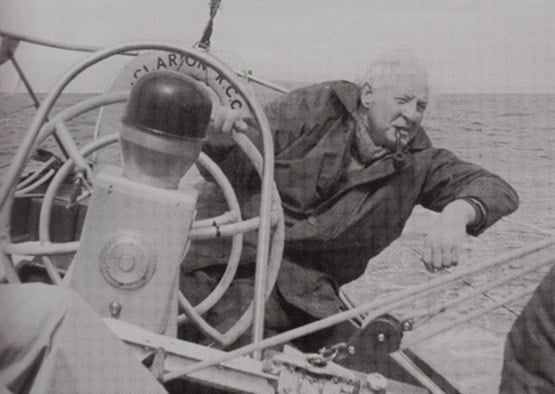
“Just keep on sailing, and you’ll get there”. The late Rory O’Hanlon at the helm of his S & S 43 Clarion with which he won the Philip Whitehead Cup in the 1971 Fastnet Race, and also cruised on long voyages. While a student at the Royal College of Surgeons in Ireland, he was active in the sailing club.
See also: Sailing Awards slideshow
The Irish Paralympic Sailing Team as part of their program to create awareness of The Rio 2016 Paralympic Games, and of the opportunities for all disabled persons to participate in sport are running a second Level Schools Competition.
The Irish Paralympic Sailing Team is made up of three members. John Twomey (Cork), who is the only man in the world to be competing in his 11th consecutive Paralympic Games. Ian Costelloe (Kerry), who will be attending his second Paralympic Games and Austin O Carroll (Dublin) who will be attending his first.
The Paralympic sailors are asking second level students to design a logo and campaign slogan for the Team and their boat. The prize for the student will be a team jacket. In addition to this the winning logo, slogan and the School’s name will be on the boat for the campaign and the Paralympic Games. Also there would be an opportunity for the student and two friends to sail with the Paralympic sailing team.
The Team are also encouraging schools to run a Casual Dress Day as a fundraiser for the Team. “We are also hoping that schools would host a casual dress day to raise awareness of the competition and funds for the Irish Paralympic sailing campaign. If the school would like a member of the team to come and address the students about what it takes to represent your country in the Paralympics then we would be delighted to provide the same.
The closing date for the competition is the 26th of February 2016 as the events that lead up to the Paralympic Games commence then and the team would like the logo and campaign slogan to be promoted for the student and the school at these events.
See details attached below.
John Twomey Of Kinsale Is Afloat.ie’s 'Sailor Of The Month' For December
2016 will mark twenty years since Afloat inaugurated the “Sailor of the Month” awards, with their peak achievement of the “Sailor of the Year” accolade. This means we have now honoured nearly 300 sports sailors of every kind, of many ages, and from all parts of Ireland. For as seasoned observers will have noted, from time to time there’s such a plethora of monthly achievement that we have to subdivide the awards into inshore and offshore divisions, and then we might be obliged to add in extra variants purely for cruising, or for international achievement on Irish waters. All of which pushes the numbers well beyond the 228 winners which nineteen years would otherwise suggest.
But no matter how we may try to shape it, the traditional Irish calendar has two weeks and more at mid-winter totally blanked off for the Yuletide seasonal celebrations, while deadlines for the Afloat Annual (the 2016 Edition will be published at the end of this week) means that from the outset, we realized that December’s winner would have to be decided by December 15th at the latest.
So for us here at Afloat.ie, the new Irish sailing season starts tomorrow. But our first New Year winner (or indeed winners) of the January 2016 Sailor of the Month award won’t be announced for another six weeks. Time was when there’d be little enough to choose from for Irish sailing achievement in these midwinter six weeks. But with the Pre-Olympic Copa Brasil De Vela Regatta of very special Irish interest getting under way today in Rio, added to the usual Irish presence in the Rolex Sydney Hobart race on December 26th (don’t forget an Irish skipper has twice won it outright), and with a record entry already shaping up for Quantum Key West Race Week in Florida from January 17th to 22nd, the judges may well be faced with multiple choices.
Refreshingly, making the choice for December has been very clearcut. The entire Irish sailing community breathed a sigh of relief and approval when John Twomey and his crew of Austin O’Carroll and Ian Costello qualified to sail for Ireland in the September 2016 Paralympic Games in Rio.
The Providence Team IRL Sonar crew looked to be battling for vital places in the trials in Melbourne, but in the end they secured the slot on December 2nd with a race to spare.
It’s an extraordinary achievement, not least in that former Kinsale YC Commodore Twomey will be racing in his 11th Olympic Games. And his experience and enthusiasm showed through in setting out to do the remaining race with as much determination as he would have shown had his Olympic place still depended on it.
But then, that’s the way John Twomey and his team are with their sailing. While they’re inevitably associated with the Sonar for international sport, in his time John has managed to compete seriously with an International Dragon in open competition, using a boat which was only slightly modified to take account of the fact that a boyhood cycle-race accident lost him the use of both legs. Such enthusiasm, allied to his achievement in qualifying for an 11th Olympics, puts him in a class of his own to be the Afloat.ie “Sailor of the Month” for December 2015.
Irish Paralympic Trio Stay Mid–Fleet
Irish Paralympic Sailors are still in contention for a place on the start line in Rio next year and remain in a mid–fleet position in the Australian 2015 Para Worlds Sailing Championships in their bid for a place on the start line in Rio next year.
Perfect sailing conditions continued in Port Phillip bay for races three and four of the 2015 Para World Sailing Championships out of Williamstown’s Royal Yacht Club of Victoria.
The breeze was generally southerly, starting at around eight knots and steadily building to approximately 12 knots in the later afternoon.
After four races, Ireland's paralympic sailors lie in 9th place, in the middle of the fleet, at the end of day two at the 2015 Para World Sailing Championships in Williamstown, Melbourne, Australia. More importantly, of the nations seeking to qualify for a place on the start line in Rio next year at the paralympics, Ireland are still in fourth position out of a possible six places.
With seven more races to go, Ian Costelloe, one of the crew of the Irish Paralympic team said: "It was a great day for sailing, the competition is really though here but we are sailing really well. Our first race today went okay for us; we played it well, but unfortunately the second race today was a bit tricker and we came out the wrong side of a windshift. But other than that we are happy with our progress and there's still a lot of sailing to be done."
Scores are quite close in this fleet and give the promise of some further great competition over the next four days.
Among the 18 boats in the Sonar fleet, Australia, Canada, France, Germany, Britain, Greece and Norway have already booked their place at Rio 2016.
However Ireland, Israel, Italy, Japan, South Korea, New Zealand, Spain, the United States and the US Virgin Islands will be chasing the remaining six spots on offer, with three teams set to miss out on berths for the Games.
The Irish Paralympic Sailing Team comprising John Twomey, Ian Costello and Austin O'Carroll is campaigning to qualify for the 2016 Rio Paralympic Games. This final qualifying event is being hosted by one of the oldest sailing clubs in Australia, the Royal Yacht Club Victoria, Williamstown, Melbourne from November 28th to the 3rd of December 2015. The event comprises of eleven races, two for each of the first five days with the final race on Dec 3rd.
The team compete in the 23 foot Sonar Class, which for Paralympic events is a two sails keelboat. The Irish team are currently ranked 5th in the world. Racing out of the Royal Yacht Club of Victoria in Williamstown, a small suburb of Melbourne, competitors are seeking to qualify for a place on the start line in the Paralymic Games in Rio, Brazil 2016. The Irish team need to secure a place in the top six overall in this championship to secure their place on the start line in Rio de Janeiro next year.
Entries from 31 countries and 81 boats comprising 142 sailors are competing for just 35 places to participate in the 2016 Paralympic Games in Rio, Brazil next year. The fleet of sailors across three different types of boats include 45 sailing the 2.4mR (single person boat), 18 sailing the SKUD 18 (two person boat) and 18 sailing the Sonar (three person boat).
In total, 35 athletes, across three fleets of boats will book their spot at Rio 2016 in Melbourne. Seven spots in the 2.4mR, five in the SKUD18 and six in the Sonar will be up for grabs.
Ireland Lying Mid–Fleet at Paralympic Worlds – Day One
Irish Paralympic Sailors at the end of day one lie mid fleet in the 2015 Para Worlds Sailing Championships in their bid for a place on the start line in Rio next year.
In beautiful sailing conditions of 11-14 knots of wind, with bright blue skies Ireland's paralympic sailors lie in 9th place at the end of day one, in the middle of the fleet at the 2015 Para World Sailing Championships in Williamstown, Melbourne, Australia. More importantly, of the nations seeking to qualify for a place on the start line in Rio next year at the paralympics, Ireland are in 4th position out of a possible six places.
With nine more races to go, John Twomey, Skipper of the three man Sonar crew said: "We had a good start today, with a hard earned 4th place in race 1. Our 2nd race was costly, as on the first beat (sailing upwind) the wind filled in better on the left side of the course while we chose the right hand side. The fleet was extremely compact in both races. A good day tomorrow is essential."
Among the 18 boats in the Sonar fleet, Australia, Canada, France, Germany, Britain, Greece and Norway have already booked their place at Rio 2016.
However Ireland, Israel, Italy, Japan, South Korea, New Zealand, Spain, the United States and the US Virgin Islands will be chasing the remaining six spots on offer, with three teams set to miss out on berths for the Games.
The Irish Paralympic Sailing Team comprising John Twomey, Ian Costello and Austin O'Carroll is campaigning to qualify for the 2016 Rio Paralympic Games. This final qualifying event is being hosted by one of the oldest sailing clubs in Australia, the Royal Yacht Club Victoria, Williamstown, Melbourne from November 28th to the 3rd of December 2015. The event comprises of eleven races, two for each of the first five days with the final race on Dec 3rd.
The team compete in the 23 foot Sonar Class, which for Paralympic events is a two sails keelboat. The Irish team are currently ranked 5th in the world. Racing out of the Royal Yacht Club of Victoria in Williamstown, a small suburb of Melbourne, competitors are seeking to qualify for a place on the start line in the Paralymic Games in Rio, Brazil 2016. The Irish team need to secure a place in the top six overall in this championship to secure their place on the start line in Rio de Janeiro next year.
Entries from 31 countries and 81 boats comprising 142 sailors are competing for just 35 places to participate in the 2016 Paralympic Games in Rio, Brazil next year. The fleet of sailors across three different types of boats include 45 sailing the 2.4mR (single person boat), 18 sailing the SKUD 18 (two person boat) and 18 sailing the Sonar (three person boat).
In total, 35 athletes, across three fleets of boats will book their spot at Rio 2016 in Melbourne. Seven spots in the 2.4mR, five in the SKUD18 and six in the Sonar will be up for grabs.
Irish Paralympic Sailors Ready for Para World Champs Challenge
Irish Paralympic Sailors ready to compete in the 2015 Para Worlds Sailing Championships in Australia for a place on the start line in Rio next year. The three sailors are ready for the challenge that awaits them when racing commences this Saturday at the 2015 Para World Sailing Championships in Williamstown, Melbourne, Australia.
Among the 18 boats in the Sonar fleet, Australia, Canada, France, Germany, Britain, Greece and Norway begin the Championships having already booked their place at Rio 2016.
However Ireland, Israel, Italy, Japan, South Korea, New Zealand, Spain, the United States and the US Virgin Islands will be chasing the remaining six spots on offer, with three teams set to miss out on berths for the Games.
The Irish Paralympic Sailing Team comprising John Twomey, Ian Costello and Austin O'Carroll is campaigning to qualify for the 2016 Rio Paralympic Games. This final qualifying event is taking place in Melbourne, Australia from November 28th to the 3rd of December 2015.
The team compete in the 23 foot Sonar Class, which for Paralympic events is a two sails keelboat. The Irish team are currently ranked 5th in the world. Racing out of the Royal Yacht Club of Victoria in Williamstown, a small suburb of Melbourne, competitors are seeking to qualify for a place on the start line in the Paralymic Games in Rio, Brazil 2016. The Irish team need to secure a place in the top six overall in this championship to secure their place on the start line in Rio de Janeiro next year.
Entries from over 30 countries and over 80 boats comprising 140 sailors are competing for just 35 places to participate in the 2016 Paralympic Games in Rio, Brazil next year. The fleet of sailors across three different types of boats include 45 sailing the 2.4mR (single person boat), 18 sailing the SKUD 18 (two person boat) and 18 sailing the Sonar (three person boat).
The 2.4mR the biggest fleet in Melbourne with 45 entries whilst the Two-Person Keelboat, the SKUD18, and the Three Person Keelboat, the Sonar, have 18 entries each. In total, 140 sailors and 70 coaches are in Melbourne with eyes focused on taking gold and securing a place on the Rio 2016 start line.
In total, 35 athletes will book their spot at Rio 2016 in Melbourne. Seven spots in the 2.4mR, five in the SKUD18 and six in the Sonar will be up for grabs.
John Twomey Resigns As Head of Disabled Sailing's Governing Body
#IFDS - Ten-time Irish Paralympian John Twomey has resigned as president of the International Association for Disabled Sailing (IFDS), as Olympics news site Inside The Games reports.
Afloat's Sailor of the Month for August 2013 departs from his role after sailing's axing from the Tokyo 2020 Paralympics was confirmed after a review by the ISAF.
Though the ISAF, with which the IFDS merged last year, says it "will continue to work hard to reinstate sailing" in future Paralympics, that charge will now be headed by Twomey's interim replacement Bernard Destrubé – who paid tribute to the Kinsale sailor's leadership during a tumultuous time for the parasport.
Inside The Games has more on the story HERE.
Paralympian Twomey Must Sail On to Secure Rio Berth
#ifds – Kinsale's John Twomey finished in the top half of the Sonar fleet at the Disabled Sailing World Championships and first 2016 Paralympic qualification Nova Scotia in Canada yesterday. Twomey, sailing with Ian Costelloe and Austin O'Carroll, was ninth from 18 starters. The sole Irish crew competing took their best result of second in the opening race of seven. A lack of consistency left means the Twomey crew leave Canada two places short of qualifying Ireland for Rio. The Kinsale Yacht Club trio have another shot at Paralympic qualification in 2015.
British sailors came away with two silver medals and the maximum three qualifying berths for the 2016 Paralympic Games at the conclusion of the IFDS Disabled Sailing World Championships in Halifax, Canada, today (24 August).
Alexandra Rickham and Niki Birrell missed out on a sixth consecutive world title by the narrowest of margins in the two-person SKUD class, while Helena Lucas claimed silver in the 2.4mR class, just one point from overall winner Heiko Kroeger of Germany.
Their podium finishes, plus a fourth place by the British Sonar trio of John Robertson, Hannah Stodel and Steve Thomas, ensured that Great Britain earned qualification across the three Paralympic classes for the Rio 2016 Games at the first time of asking.
Defending SKUD World Champions Rickham and Birrell finished their regatta tied on points with the Australian Paralympic Champions Dan Fitzgibbon and Liesl Tesch, but lost on countback after the 11-race series.
Final top three:
Sonar
1. Bruno Jourdren / Nicolas Vimont-Vicary / Eric Flageul, FRA, 21 points
2. Paul Tingley / Scott Lutes / Logan Campbell, CAN, 25
3. Colin Harrison / Jonathan Harris / Russell Boaden, AUS, 26
SKUD 18
1. Daniel Fitzgibbon / Liesl Tesch, AUS, 21
2. Alexandra Rickham / Niki Birrell, GBR, 21
3. Marco Gualandris / Marta Zanetti, ITA, 28
2.4mR
1. Heiko Kroeger, GER, 37
2. Helena Lucas, GBR, 38
3. Damien Seguin, FRA, 39
Kinsale Yacht Club Perpetual Trophy (The Nations Cup)
1. Australia
2. Great Britain
3. Canada
4. United States
5. Italy
6. Spain
7. New Zealand
Kinsale Yacht Club Trio Aim for Rio Paralympic Sailing Qualification in Nova Scotia
#paralympicsailing – Kinsale Yacht Club's John Twomey, Ian Costello and Austin O'Carroll will represent Ireland tomorrow in the three-man Sonar class tomorrow at the Disabled Sailing (IFDS) World Championships in Halifax, Nova Scotia, Canada. They will compete in the six day regatta against 16 of the world's best Paralympic sailing teams from 12 other nations.
The event serves as the first qualifying event for the discipline, with the top seven nations earning their country's place at the Games in Rio in two years' time.
John Twomey from Ballinhassig, Co. Cork, John will draw on his extensive experience to lead his two crewmen, having represented Ireland in a record-breaking 10 consecutive Paralympic Games. His teammate Ian Costello from Killorgan in Co. Kerry is also no stranger to international competition having sailed with John in his first Paralympics in 2012 where they finished 11th overall. This will be Dubliner Austin O'Carroll's first major international event having joined the team late last year.


























